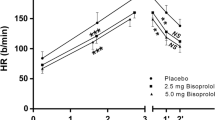Summary
In order to test the additional efficacy of the combination of a beta blocker (penbutolol 40 mg single dose) with molsidomine (2 mg single dose), a double blind cross-over trial was performed in 30 patients with stable angina pectoris. Stress tests were done before and 1 h after the beta blocker alone and the combination therapy. Some training effect could be detected on comparing results from the first and second days. Combined therapy showed a better response of resting systolic arterial pressure, resting and maximal diastolic pressure, heart rate gain (from rest to maximal effort) and particularly in the angina severity score. All of these variables changed significantly in comparison to the beta blocker alone, 46 out of 60 post-drug ergometric studies were negative; of the 14 positive tests, 11 followed the beta blocker and only 3 the combined therapy. The combination of a preload reducer molsidomine and a beta blocker may be adequate for patients only partially compensated or with cardiomegaly and/or a depressed ejection fraction.
Similar content being viewed by others
References
Russek HI (1967) Propranolol and isosorbide dinitrate synergism in angina pectoris. Am J Med Sci 254: 406–409
Aronow WS (1972) The medical treatment of angina pectoris. VI. Propranolol as an antianginal drug. Am Heart J 84 (5): 706–709
Aronow WS (1972) The medical treatment of angina pectoris. VII. Newer beta-adrenergic blockers as antianginal drugs. Am Heart J 84(/): 834–837
Gillam PMS, Prichard BNS (1965) Use of propranolol in angina pectoris. Br Med J 2: 337–339
Wolfson S, Heinle RA, Herman MV, Kemp HG, Sullivan JM, Gorlin R (1966) Propranolol and angina pectoris. Am J Cardiol 18: 345–353
The Norwegian Multicentre Study Group (1981) Timolol-induced in mortality and reinfarction in patients surviving acute myocardial infarction. N Engl J Med 304: 801–807
Greenblat DJ, Koch-Weser J (1974) Adverse reactions to beta-adrenergic receptor blocking drugs: a report from the Boston Collaborative drug surveillance program. Drugs 7: 118–129
Grizzle JE (1965) The two-period change-over design and its use in clinical trials. Biometrics 21: 467–480
Hills M, Armitage P (1979) The two-period cross-over clinical trial. Br J Clin Pharmacol 1: 7–20
Jun HW, Hayes SL, Vallner JJ, Honigberg IL, Rojos AE, Stewart JT (1979) Plasma level profiles and clinical response of penbutolol after three different single oral doses in man. J Clin Pharmacol 19: 415–423
Witchitz S, Kolsky H, Moisson P (1982) Ergometric study of betablocker vasodilator combination. World congress of Cardiology, 9. Moscow, 1982. Abstract 0481, Vol 1
Russek H (1968) Propranolol and isosorbide dinitrate synergism in angina pectoris. Am J Cardiol 21: 44
Battock DJ, Alvarez H, Chidsey CA (1969) Effects of propranolol and isosorbide dinitrate on exercise performance and adrenergic activity in patients with angina pectoris. Circulation 39: 157
Aronow WS, Kaplan MA (1969) Propranolol combined with isosorbide dinitrate versus placebo in angina pectoris. N Engl J Med 280: 847
Stauch M, Nechwatal W, Sigel H, Bitter F, Adam WE (1982) Effects of Molsidomine and metoprolol on global and regional left ventricular function at rest and during exercise in coronary heart disease. World Congress of Cardiology, 9, Moscow, 1982. Abstract 1202, Vol 2
Orodá LA, Vazquez A, Paz N, Aptecar M (1982) Serial echocardiographic evaluation of effects and duration of action of Molsidomine (M). Double blind acute study in normals. World Congress of Cardiology, 9, Moscow, 1982. Abstract 0297, Vol 2
Takeshita A, Nakamura M, Tajima T, Matsuguchi H, Kuroiwa Tanaka A, Kikuchi Y (1977) Long-lasting effect of oral molsidomine on exercise performance. Circulation 55: 401
Guerchicoff S, Vazquez A, Kunik H, Drajer S, Diaz F (1978) Acute double-blind trial of a new anti-anginal drug: Molsidomine. Eur J Clin Pharmacol 13: 247
Majid PA, DeFeyter PJF, Van der Wall EE, Wardeh R, Roos JP (1980) Molsidomine in the treatment of patients with angina pectoris. Acute hemodynamic effects and clinical efficacy. N Engl J Med 302: 1
Author information
Authors and Affiliations
Rights and permissions
About this article
Cite this article
Balestrini, A.E., Menzio, A.C., Cabral, R. et al. Penbutolol and molsidomine synergism in angina pectoris. A double blind ergometric trial. Eur J Clin Pharmacol 27, 1–5 (1984). https://doi.org/10.1007/BF02395197
Received:
Revised:
Accepted:
Issue Date:
DOI: https://doi.org/10.1007/BF02395197




